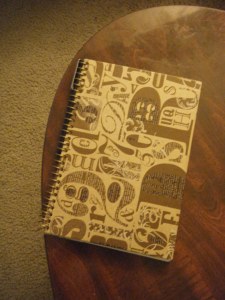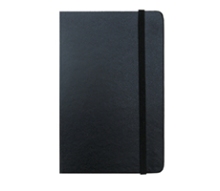This is my scribblebook.

If you pick it up and leaf through its pages, you will find a random assortment of images and words: Grocery lists, to-do lists, notes for a paper or from a lecture. Song lyrics that are stuck in my head. Doodles from when I am bored or I can’t exactly think straight.
I have a lot of “journals.” When your friends and family find out that you write poetry, all your gifts often become these journals. I have nearly a dozen by now, piled in my closet. They have colorful covers and gilt-edged pages, sometimes with an elegant little ribbon to mark my place.
These books are beautiful—and intimidating. They seem too good for everyday use. Only deep thoughts, fully formed essays, important musings about the world, deserve to go on their creamy pages. Which is probably why, if you look through my heap of journals, you’ll find that most of them have writing on only the first page. After that I tend to sputter out.

At least I did, until I started to keep a scribblebook. In order to start writing, I found, I had to get away from the picture-perfect journals. I tried the classic Moleskine notebooks for a while—they were simpler, at least—but I still wound up with a leather-bound book of blank pages. These are the notebooks Hemingway and Picasso used—what I’m writing isn’t nearly up to snuff.
If I was going to keep my inner critic silent for any length of time, I had to go simpler. Which is how I ended up with my scribblebooks. Bright colored plastic covers, simple college-ruled pages. And I started carrying it with me everywhere I went. I filled up notebook after notebook with scraps of poetry and driving directions on the same page.
Of course, being a word-person, once I settled on a notebook I had to find a name. “Notebook” didn’t seem specific enough. I’d already given up on “journal” when I piled my unfinished gift books in the closet. And heaven forbid I use the word “diary.”
Somewhere along the line I settled for the word “scribblebook.” Which has stuck.
Keeping this scribblebook, for me, has become a spiritual practice. It keeps me grounded in the now, instead of in the distant future. It holds my life together, my whole self—the practical moments and the ethereal moments. Because the only way I know how to write, and to pray, is tangled up in the stuff of my everyday life. The only way I know how to pray is in between grocery lists and doodled diagrams.
And the only way I know how to pray is to notice. I don’t have a smartphone, I don’t carry a camera with me most days. If I encounter something that stops me in my tracks—an image or moment that captures my attention—the only way to catch hold of it is to write it down.
I write it down, and let it rest amidst all the work of my everyday life. And maybe it will sprout into a sermon or a poem or an essay.
This online “scribblebook,” I hope, will slowly fill up with the scribbles that take root. They’ll be full of the things I notice: about my work as a college administrator and a student of Christian worship; about my Buddhist-Christian marriage and how it slowly takes shape; about gender, about art, about God. These are the ideas that have turned into more complicated pieces, but as in the pages of my scribblebook, they’ll make more sense if they come mixed in with the stuff of my everyday life. For it is in the images I notice around me that I can make sense of the world.
So here’s to the blank page, the pen at the ready. Here’s to creating something new.